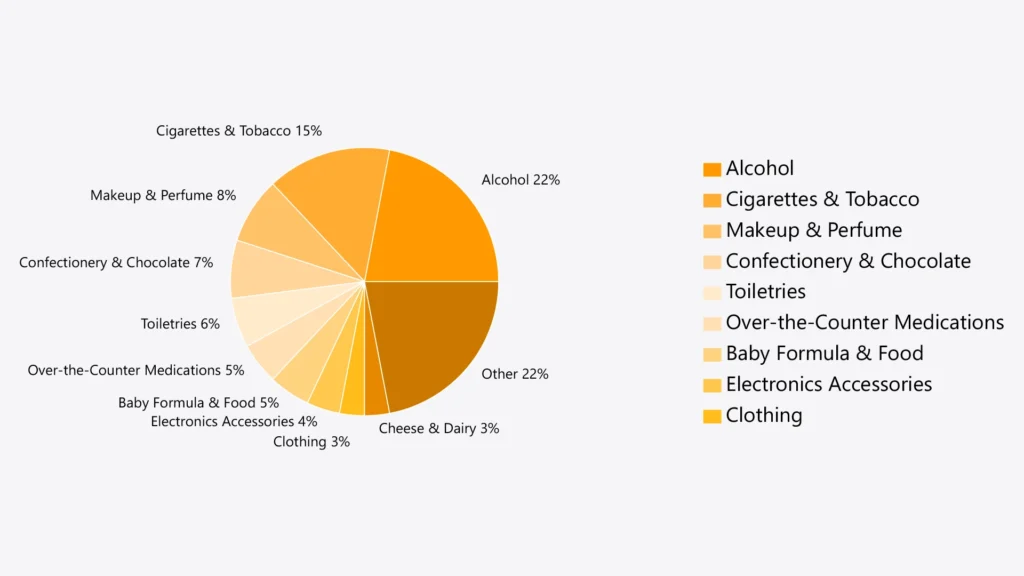Supermarkets face theft regularly, affecting both their profits and overall stock control. Theft rates can fluctuate based on economic conditions, and the items most commonly targeted for theft are those that are either expensive or easy to resell. To understand how to better protect against these losses, take a look at our Retail Security Solutions.

In this article, we will take a closer look at the most stolen items from supermarkets and provide some insight into why these products are targeted. Additionally, we’ll include relevant metrics and data to paint a clear picture of the impact of these thefts on the industry.
Table of Contents
15 Of the Most Stolen Items from Supermarkets

Certain products attract thieves more frequently due to their high value or high demand. Below are the top ten items that are regularly stolen from supermarkets.
1- Alcohol
Alcohol, especially high-end spirits and wines, is one of the most frequently stolen items. According to the Associated of Convenience Stores, theft of alcoholic beverages accounted for over 22% of all retail thefts in 2022. Due to its high resale value, alcohol is often stolen in larger quantities. Supermarkets lose millions each year from stolen alcohol, making it a prime target for shoplifters.
Due to the addiction to alcohol and its easy accessibility in all places, it’s not that hard for thieves to steal and sell it in the black markets. To prevent the theft of costly bottles like champagne and whisky, most retailers place dummy bottles and cases.
Alcohol theft is often linked to addiction. People struggling with alcoholism or those stealing to support other habits, like drugs or gambling, sometimes go to great lengths to steal alcohol. Some even try to hide it themselves to avoid being caught.
On top of that, alcohol is a popular item, and smaller shops facing high costs from suppliers may end up buying stock from thieves. This black market for stolen alcohol is behind many of the bigger thefts across the country.
2- Confectionery & Chocolate
Though seemingly low in value, chocolate and sweets are popular theft items due to their small size and ease of concealment. Studies have shown that confectionery thefts make up nearly 7% of all stolen grocery items. In a survey conducted by the British Retail Consortium (BRC), chocolate was found to be the most stolen food item in the UK.
Many believe that it’s mainly younger people or teens who steal snacks like candy and chocolate. This seems understandable since boredom, peer influence, or simply wanting something they can’t afford might push them to do so. However, there is a market for stolen sweets, and thieves are aware of how in-demand these items can be.
The rising costs of confectionery, spurred by inflation, sugar taxes, and the ongoing cost-of-living crisis, have only exacerbated the issue. As prices climb, more people find these everyday treats increasingly out of reach, prompting a spike in thefts.
For more detailed insights, check out our retail crime statistics blog post that delves into the broader impact of shoplifting on businesses across the UK.
Retailers face a growing challenge in managing this trend, making effective retail security measures more critical than ever to combat these thefts and protect their businesses.
3- Baby Formula & Food
Baby formula is both expensive and in high demand, making it an attractive target for thieves. Statistics from the UK retail industry indicate that baby formula thefts have increased by 18% over the last two years. This is driven not only by individuals struggling financially but also by organised crime groups who resell stolen products on the black market.
This problem isn’t unique to one family or area. According to a report by Sky News, many struggling families have resorted to stealing baby formula and food to feed their children. While some feel ashamed or embarrassed, the rising cost of living often leaves them with no other choice. This growing issue highlights the difficult decisions parents face in today’s economy.
The rising cost of baby formula is a major issue, with prices increasing by as much as 45% for some brands in the last two years. Unfortunately, black market thieves also exploit this demand, selling stolen formula for profit and taking advantage of vulnerable families. This problem has only worsened in recent years, reflecting the growing struggles of modern society.
4- Nappies & Baby Wipes
Baby products, including nappies and wipes, are frequently stolen due to their necessity and high cost. It’s estimated that nappies are involved in around 5% of supermarket thefts. The increase in the cost of baby items has made them more appealing for theft, with some individuals resorting to stealing them for personal use or resale.
The average cost of nappies for one child can range from £12 to £24 per month, making them a significant expense for many families. With tighter budgets, nappies have become a frequent target for shoplifting, especially for those who can’t afford reusable options or the ongoing costs of disposable ones.
5- Baby Clothes
Similar to other baby items, baby clothes are frequently targeted. Parents facing financial difficulties may resort to theft when they cannot afford new clothing for their children. Industry estimates suggest that baby clothing thefts account for approximately 4% of all stolen supermarket items.
6- Raw Meat
Raw meat, particularly high-value cuts like steak and lamb, is a favourite among shoplifters. The Association of Convenience Stores (ACS) reported that meat theft increased by 28% in 2023, with the cost of living crisis cited as a major factor. Stolen meat is often resold to restaurants or other individuals.
The black market for meat has been around for decades, particularly in economically struggling areas, where stolen goods are often sold in local pubs or public places.
In response, supermarkets have started using protective cases on meat products, which are removed only when scanned at checkout. Despite efforts by police, like a recent initiative in Nottinghamshire, the rising cost of living has made meat theft even more frequent across the UK.
7- Cheese & Dairy Products
Cheese is a surprisingly popular target for theft. It is estimated that dairy products, including cheese, are involved in 3% of all retail thefts. Cheese’s long shelf life and relatively high cost make it attractive to thieves, especially as the price of food continues to rise.
8- Toiletries
Toiletries such as shampoo, deodorant, and toothpaste are often targeted due to their necessity. According to the BRC, toiletries represent 6% of all supermarket thefts, with many stolen items being resold in informal markets.
9- Makeup & Perfume
High-end makeup and perfumes are easy to conceal and often have a high resale value. This makes them prime targets for theft. A recent report showed that beauty products account for around 8% of stolen goods from supermarkets, making them one of the most common non-food items stolen.
The global makeup market is huge, valued at £32 billion and expected to grow beyond £50 billion in the coming years. Even in the UK, where budgets are tight, makeup remains a profitable business for both large and small companies. However, this popularity has made cosmetics a major target for shoplifters, especially in larger stores where security might be less focused.
High-demand products like mascara, foundation, and lipstick, which are small but valuable, are particularly attractive to thieves looking to make quick cash.
10- Clothing
Supermarkets that sell clothing often see high rates of theft, particularly of smaller, easy-to-hide items like t-shirts, socks, and hats. Clothing thefts make up around 3% of supermarket theft incidents.
11- Cigarettes and Tobacco
Cigarettes and tobacco products are a huge target for thieves, accounting for nearly 15% of retail thefts. Despite being stored behind counters, criminals often resort to smash-and-grab tactics to access these items. Tobacco products are highly valuable and in demand on the black market.
12- Coffee
Premium coffee brands are increasingly stolen due to their high price. In 2023, coffee thefts increased by 12%, driven by the rising cost of living and high consumer demand. These products are often resold in smaller stores or through informal networks.
13- Batteries
Batteries are small, easy to conceal, and essential for many devices, making them a frequent target for shoplifters. Theft of batteries increased by 9% in 2022, according to the ACS.
14- Over-the-Counter Medications
Medications like painkillers and cold medicine are often stolen due to their high demand and price. Research indicates that these items make up around 5% of stolen supermarket products.
15- Electronics Accessories
Items such as phone chargers and headphones are stolen frequently, particularly in larger supermarkets. Electronics accessories account for approximately 4% of retail thefts, often due to their high resale value and ease of concealment.
Why Are These Items Stolen?
There are several reasons why these items are frequently stolen, with some common factors being:
Economic Pressure
The rising cost of living has made essential items like food, baby products, and toiletries more expensive, which in turn drives up theft rates. A survey in 2023 found that nearly 40% of shoplifting incidents were motivated by financial hardship.
Addiction
Items like alcohol, cigarettes, and medications are often stolen by individuals struggling with addiction. These items can be costly, and addiction may drive people to theft in order to satisfy their cravings.
Resale Value
High-value items such as alcohol, meat, and cosmetics are often stolen with the intent of being resold, either on the black market or through informal networks. These items have a high resale value, making them attractive to both opportunistic thieves and organised crime groups.
Ease of Theft
Small, easily concealed items such as confectionery, makeup, and batteries are often targeted because they can be slipped into a pocket or bag with minimal risk of detection.
What Is the Most Stolen Food in the World?
According to the most recent research and statistics, cheese is the most stolen food in the world. Now you might be thinking about the reason. Let us make it clear to you, cheese is one of the widely used foods and is available in every supermarket, grocery store, and shop.
Due to this high demand, the black market also exists, which buys the stolen cheese and sells it at cheaper rates. According to statistics, almost 4% of the world’s cheese gets stolen every year and is being sold on the black market for a good amount.
There are other things as well, including chocolates, alcohol, meat, and more. But when talking about the most stolen food in the world, cheese is the thing that is at the top of the list.
How Do I Protect My Supermarket Against Theft and Vandalism?
Theft and vandalism are common issues in the UK and every year cost millions of pounds to businesses. To ensure the security of your business or supermarket, you can hire professional and reliable security guards, install CCTV cameras, and set up security alarm systems.
The Financial Impact on Supermarkets
Retail theft has a significant financial impact on supermarkets. According to the British Retail Consortium, retail crime costs businesses over £1 billion annually, with shoplifting accounting for a large portion of this figure. Supermarkets are particularly hard hit, losing millions of pounds each year due to theft. As a result, many stores have implemented strict security measures, including CCTV cameras, security tags on high-value items, and hiring additional security staff.
Theft in supermarkets is a widespread issue, with certain items being targeted more than others due to their value or necessity. While security measures have been implemented to reduce theft, the rising cost of living and demand for high-value goods have made it a persistent problem. Understanding which items are most commonly stolen helps supermarkets better protect their stock and prevent losses.
However, in addition to retail theft, certain locations are known for other types of crimes, such as pickpocketing. You can learn more about this by checking out our article on the Worst Areas for Pickpocketing Offences.
Get Free Consulting with Guard Mark Security
Worried about stolen items? Guard Mark Security offers tailored solutions to safeguard your supermarket. Book a Free Consultation today and secure your business!

